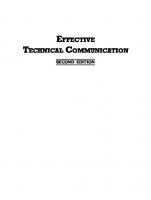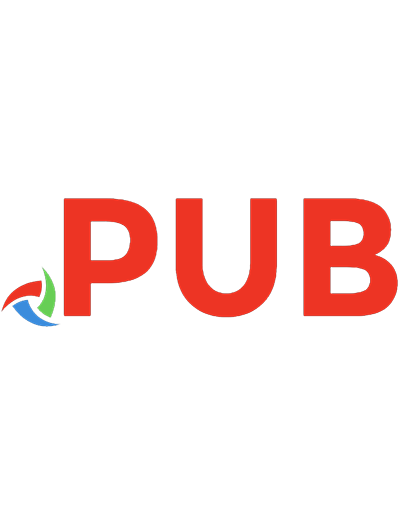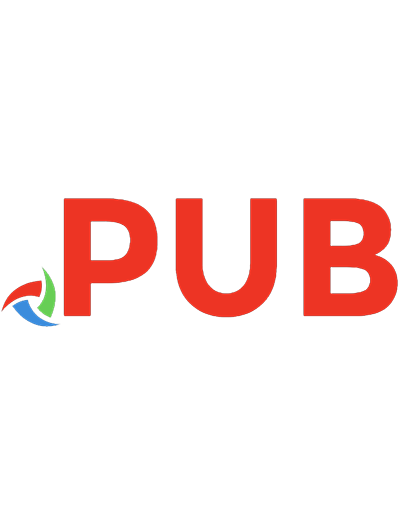Technical communication [Fourteenth edition] 9780134118499, 1292154292, 9781292154299, 0134118499, 9780134678825, 0134678826
For courses in Technical Communication. Comprehensive, user-friendly instruction in workplace writing, technical communi
1,427 322 20MB
English Pages xxviii, 708 pages; 24 cm [737] Year 2016;2017
Table of contents :
Cover......Page 1
Title Page ......Page 8
Copyright Page ......Page 9
Brief Contents ......Page 10
Detailed Contents ......Page 11
Preface ......Page 23
Part 1 Communicating in the Workplace......Page 30
Chapter 1 Introduction to Technical Communication......Page 31
What Is Technical Communication? ......Page 32
Technical Communication Reaches a Global Audience ......Page 33
Technical Communication Is Part of Most Careers ......Page 34
Technical Communicators Play Many Roles ......Page 35
Accessible and Efficient ......Page 36
Documents That Inform ......Page 38
Preparing Effective Technical Documents ......Page 39
Case Providing Information Readers Can Use ......Page 40
Case Considering the Ethical Issues ......Page 41
Case Working on a Team and Thinking Globally ......Page 42
Projects......Page 43
Chapter 2 Meeting the Needs of Specific Audiences......Page 44
Your Relationship to Your Readers ......Page 46
Intended Use of the Document ......Page 47
Highly Technical Audience ......Page 48
Semitechnical Audience ......Page 49
Nontechnical Audience ......Page 51
Case Tailoring a Single Document for Multiple Audiences......Page 52
Length and Details ......Page 53
Format and Medium ......Page 54
Budget ......Page 55
Guidelines for Analyzing Your Audience and Its Use of the Document......Page 56
Case Developing an Audience and Use Profile ......Page 57
Projects......Page 60
Chapter 3 Persuading Your Audience......Page 62
Identify Your Specific Persuasive Goal ......Page 64
Try to Predict Audience Reaction ......Page 65
Expect Audience Resistance ......Page 66
Know How to Connect with the Audience ......Page 67
Case Connecting with the Audience ......Page 68
Allow for Give-and-Take......Page 69
Never Ask for Too Much ......Page 70
Organizational Constraints ......Page 71
Ethical Constraints ......Page 72
Social and Psychological Constraints ......Page 73
Consider This: People Often React Emotionally to Persuasive Appeals ......Page 74
Support Your Claims Convincingly ......Page 75
Offer Convincing Evidence ......Page 76
Appeal to Common Goals and Values ......Page 77
Consider the Cultural Context ......Page 78
Guidelines for Persuasion......Page 80
Shaping Your Argument ......Page 82
Checklist: Persuasion......Page 86
Projects......Page 87
Chapter 4 Weighing the Ethical Issues......Page 88
Recognize Unethical Communication in the Workplace ......Page 90
Yielding to Social Pressure ......Page 91
Understand the Potential for Communication Abuse ......Page 92
Exaggerating Claims About Technology ......Page 93
Exploiting Cultural Differences ......Page 94
Consider Ethical Issues and Digital Information ......Page 95
Reasonable Criteria for Ethical Judgment ......Page 96
Ethical Dilemmas ......Page 97
Case a Hard Choice ......Page 98
Learn to Recognize Legal Issues and Plagiarism ......Page 99
Plagiarism and Your Career ......Page 101
Consider This: Ethical Standards Are Good for Business Decide When and How to Report Ethical Abuses ......Page 103
Checklist: Ethical Communication......Page 105
Guidelines for Ethical Communication......Page 107
projects......Page 108
Chapter 5 Teamwork and Global Considerations......Page 109
Virtual Teamwork ......Page 110
Guidelines for Managing a CollaborativeProject......Page 112
Guidelines for Running a Meeting......Page 114
Gender Differences ......Page 115
Managing Group Conflict ......Page 116
Guidelines for Active Listening......Page 117
Brainstorm as a Way of Getting Started ......Page 118
Mind-Mapping......Page 119
Reviewing and Editing Others’ Work ......Page 121
Guidelines for Peer Reviewing and Editing......Page 122
Hoarding Information ......Page 123
Interpersonal Issues in Global Teams ......Page 124
Guidelines for Communicating on a Global Team......Page 126
Checklist: Teamwork and Global Considerations......Page 127
Projects......Page 129
Chapter 6 An Overview of the Technical Writing Process......Page 130
Critical Thinking in the Writing Process ......Page 131
A Sample Writing Situation ......Page 133
Working with the Information ......Page 135
Planning the Document ......Page 136
Drafting the Document ......Page 138
Revising the Document ......Page 139
Guidelines for Proofreading......Page 143
Digital Technology and the Writing Process ......Page 144
Checklist: Proofreading......Page 145
Projects......Page 146
Part 2 The Research Process......Page 148
Chapter 7 Thinking Critically About The Research Process......Page 149
Exploring a Balance of Views ......Page 151
Achieving Adequate Depth in Your Search......Page 153
Evaluating and Interpreting Your Findings ......Page 154
Primary Versus Secondary Sources ......Page 155
Locating Secondary Sources Using Wikipedia ......Page 156
Other Web-based Secondary Sources ......Page 157
Guidelines for Researching on theInternet......Page 160
Traditional Secondary Sources ......Page 162
Surveys ......Page 165
Guidelines for Informational Interviews......Page 167
Guidelines for Surveys......Page 168
Observations and Experiments ......Page 170
Consider This: Frequently Asked Questions About Copyright ......Page 173
Projects......Page 174
Chapter 8 Evaluating and Interpreting Information......Page 176
Evaluate the Sources ......Page 178
Evaluate Online Information......Page 179
Evaluate the Evidence ......Page 180
Identify Your Level of Certainty ......Page 181
Examine the Underlying Assumptions ......Page 182
Consider This: Standards of Proof Vary for Different Audiences ......Page 183
Faulty Generalization ......Page 184
Faulty Causal Reasoning ......Page 185
Faulty Statistical Analysis ......Page 187
Obstacles to Validity and Reliability ......Page 191
Deceptive Reporting ......Page 192
Guidelines for Evaluating and InterpretingInformation......Page 193
Checklist: The Research Process......Page 195
Projects......Page 196
Chapter 9 Summarizing Research Findings and Other Information......Page 197
Considering Audience and Purpose ......Page 198
Guidelines for Summarizing Information......Page 200
Creating a Summary ......Page 201
Special Types of Summaries ......Page 202
Closing Summary ......Page 204
Descriptive Abstract (“Abstract”)......Page 206
Digital and Ethical Considerations in Summarizing Information ......Page 207
Checklist: Summaries......Page 209
Projects......Page 210
Part 3 Organization, Style, and Visual Design......Page 212
Chapter 10 Organizing for Readers......Page 213
The Typical Shape of Workplace Documents ......Page 214
An Outlining Strategy ......Page 217
The Formal Outline ......Page 218
Storyboarding ......Page 220
The Support Paragraph ......Page 222
The Topic Sentence ......Page 223
Paragraph Coherence ......Page 224
Paragraph Length ......Page 225
Chunking ......Page 226
Providing an Overview ......Page 227
Checklist: Organizing Information......Page 228
Projects......Page 229
Chapter 11 Editing for a Professional Style and Tone......Page 230
Avoid Ambiguous Pronoun References ......Page 232
Arrange Word Order for Coherence and Emphasis ......Page 233
Use Active Voice Whenever Possible ......Page 234
Use Passive Voice Selectively ......Page 236
Editing for Conciseness ......Page 237
Avoid Needless Repetition ......Page 238
Delete Needless Prefaces ......Page 239
Avoid Weak Verbs ......Page 240
Avoid Nominalizations ......Page 241
Make Negatives Positive ......Page 242
Delete Needless Qualifiers ......Page 243
Combine Related Ideas ......Page 244
Finding the Exact Words ......Page 246
Prefer Simple and Familiar Wording ......Page 247
Avoid Useless Jargon ......Page 248
Avoid Misleading Euphemisms ......Page 249
Avoid Imprecise Wording ......Page 250
Be Specific and Concrete ......Page 251
Adjusting Your Tone ......Page 252
Address Readers Directly ......Page 254
Prefer the Active Voice ......Page 255
Avoid Personal Bias ......Page 256
Guidelines for Nonsexist Usage......Page 257
Avoid Biased Usage of All Types ......Page 258
Considering the Global Context ......Page 259
Legal and Ethical Implications of Word Choice ......Page 260
Using Digital Editing Tools Effectively ......Page 261
Checklist: Style......Page 262
Projects......Page 264
Chapter 12 Designing Visual Information......Page 265
Why Visuals Matter ......Page 266
When to Use Visuals ......Page 267
Types of Visuals to Consider ......Page 268
How to Choose the Right Visuals ......Page 270
Using Software to Create Visuals ......Page 271
Tables ......Page 272
How to Construct a Table ......Page 275
Bar Graphs ......Page 276
Line Graphs ......Page 278
Guidelines for Creating Tables and Graphs......Page 283
Pie Charts ......Page 284
Gantt and PERT Charts......Page 286
Guidelines for Creating Charts......Page 289
Graphic Illustrations ......Page 290
Diagrams ......Page 291
Maps ......Page 293
Symbols and Icons ......Page 294
Photographs ......Page 295
Using Color ......Page 298
Videos ......Page 297
Guidelines for Incorporating Color......Page 301
Present the Complete Picture ......Page 302
Don’t Mistake Distortion for Emphasis ......Page 303
Cultural Considerations ......Page 304
Guidelines for Obtaining and Citing Visual Material......Page 306
Guidelines for fitting Visuals with text......Page 307
Checklist: Visuals......Page 308
projects......Page 309
Chapter 13 Designing Pages and Documents......Page 311
Page Design in Workplace Documents ......Page 312
Word Processing and Desktop Publishing ......Page 315
Using Style Guides and Style Sheets ......Page 316
Shaping the Page ......Page 317
Styling the Words and Letters ......Page 322
Adding Emphasis ......Page 325
Using Headings for Access and Orientation ......Page 326
Audience Considerations in Page Design ......Page 329
Adobe Acrobat™ and PDF Files......Page 331
Web Pages ......Page 332
Checklist: Page Design......Page 333
Projects......Page 334
Part 4 Specific Documents and Applications......Page 336
Chapter 14 Email and Text Messages......Page 337
Email Parts and Format ......Page 338
Email Style and Tone ......Page 340
Interpersonal Issues and Email ......Page 341
Ethical and Legal Issues When Using Email ......Page 343
Privacy and Other Ethical Issues ......Page 344
Global Considerations When Using Email ......Page 345
Guidelines for Writing and Using Email......Page 346
Text Messaging ......Page 348
Guidelines for Text Messaging......Page 349
Projects......Page 350
Chapter 15 Workplace Memos and Letters......Page 352
Considering Audience and Purpose ......Page 353
Memo Parts and Format ......Page 354
Memo Tone ......Page 358
Transmittal Memo ......Page 360
Summary or Follow-up Memo ......Page 361
Routine Miscellaneous Memo ......Page 362
Guidelines for Memos......Page 364
Checklist: Memos......Page 366
Considering Audience and Purpose ......Page 367
Standard Parts ......Page 368
Optional Parts ......Page 371
Formats and Design Features ......Page 373
Letter Tone ......Page 374
Be Polite and Tactful ......Page 375
Decide on a Direct or Indirect Organizing Pattern ......Page 376
Global and Ethical Considerations ......Page 377
Conveying Bad or Unwelcome News ......Page 379
Guidelines for Conveying Bad News......Page 380
Inquiry Letters ......Page 381
Claim Letters ......Page 385
Adjustment Letters ......Page 390
Sales Letters ......Page 388
Checklist: Letters......Page 393
Projects......Page 394
Chapter 16 Résumés and Other Job-Search Materials......Page 396
Assessing Your Skills and Aptitudes ......Page 397
Learn to Network ......Page 398
Parts of a Résumé ......Page 400
Organizing Your Résumé ......Page 402
Guidelines for Writing and Designing Your Résumé......Page 405
Unsolicited Application Letters ......Page 407
Guidelines for Application Letters......Page 410
Digital Versus Print Job Application Materials ......Page 411
Guidelines for Digital Job Application Materials......Page 412
Dossiers ......Page 413
Guidelines for Dossiers, Portfolios,and E-Portfolios......Page 414
Interviews and Follow-Up Letters......Page 415
Interviews ......Page 416
Follow-Up Letters......Page 417
Guidelines for Interviews and Follow-Up Letters......Page 419
Checklist: Résumés......Page 420
Checklist: Supporting Materials......Page 421
Projects......Page 422
Chapter 17 Technical Definitions......Page 423
Considering Audience and Purpose ......Page 424
Legal, Ethical, Societal, and Global Implications ......Page 425
Parenthetical Definitions ......Page 426
Sentence Definitions ......Page 427
Methods for Expanding Definitions ......Page 428
History ......Page 429
Analysis of Parts ......Page 430
Required Conditions ......Page 431
An Expanded Definition for Semitechnical Readers ......Page 432
Placing Definitions in a Document ......Page 437
Guidelines for Definitions......Page 439
Checklist: Definitions......Page 440
Projects......Page 441
Chapter 18 Technical Descriptions, Specifications, and Marketing Materials......Page 442
Types of Technical Descriptions ......Page 443
Objectivity in Technical Descriptions ......Page 444
Clearest Descriptive Sequence ......Page 447
Outlining and Writing a Product Description ......Page 449
Outlining and Writing a Process Description ......Page 450
A Process Description for a Nontechnical Audience ......Page 453
Specifications ......Page 454
Types of Specifications ......Page 457
Considering Audience and Purpose ......Page 458
Technical Marketing Materials ......Page 460
Guidelines for Technical marketing Materials......Page 463
Checklist: for Specifications......Page 464
Checklist: Technicalmarketing Materials......Page 465
Projects......Page 466
Chapter 19 Instructions and Procedures......Page 468
Considering Audience and Purpose ......Page 469
Formats for Instructional Documents ......Page 470
Faulty Instructions and Legal Liability ......Page 472
Informed Content ......Page 473
Appropriate Level of Detail and Technicality ......Page 474
Guidelines for Providing AppropriateDetail......Page 477
Notes and Hazard Notices ......Page 479
Readability ......Page 480
Guidelines for Designing Instructions......Page 483
Introduction ......Page 484
A Complete Set of Instructions for a Nontechnical Audience ......Page 485
Video Instructions ......Page 488
Scripting Online Videos ......Page 489
Evaluating the Usability of Instructions and Procedures ......Page 491
Usability and the User Experience ......Page 493
Approaches for Evaluating a Document’s Usability ......Page 494
Checklist: Instructions and Procedures......Page 497
Projects......Page 498
Chapter 20 Informal Reports......Page 500
Informational Versus Analytical Reports ......Page 501
Progress Reports ......Page 502
Periodic Activity Reports ......Page 504
Guidelines for Trip Reports......Page 507
Guidelines for Meeting Minutes......Page 510
Feasibility Reports ......Page 511
Guidelines for Feasibility Reports......Page 512
Guidelines for Recommendation Reports......Page 514
Guidelines for Justification Reports......Page 516
Checklist: Informal Reports......Page 518
projects......Page 520
Chapter 21 Formal Analytical Reports......Page 521
Causal Analysis: “Why Does X Happen?"......Page 523
Case the Reasoning Process in Comparative Analysis ......Page 524
Combining Types of Analysis ......Page 525
Adequate but Not Excessive Data ......Page 526
Fully Interpreted Data ......Page 527
Valid Conclusions and Recommendations ......Page 529
Self-Assessment......Page 530
An Outline and Model for Analytical Reports ......Page 532
Introduction ......Page 533
Body ......Page 534
Conclusion ......Page 541
Front Matter and End Matter Supplements ......Page 543
Letter of Transmittal ......Page 544
End Matter ......Page 545
A Formal Report ......Page 546
Guidelines for Reasoning through an Analytical Problem......Page 560
Checklist: Analytical Reports......Page 562
Projects......Page 563
Chapter 22 Proposals......Page 565
Considering Audience and Purpose ......Page 566
The Proposal Process ......Page 567
Case Submitting a Competitive Proposal ......Page 568
Types of Proposals ......Page 569
Research Proposals ......Page 570
A Forecasting Title or Subject Line ......Page 574
A Clear Focus on Benefits ......Page 576
Honest and Supportable Claims ......Page 577
Readability ......Page 578
Accessible Page Design ......Page 579
Proper Citation of Sources and Contributors ......Page 580
Introduction ......Page 581
Body ......Page 583
Guidelines for Proposals......Page 586
A Formal Proposal ......Page 587
Checklist: Proposals......Page 599
Projects......Page 600
Chapter 23 Oral Presentations and Video Conferencing......Page 601
Advantages and Drawbacks of Oral Presentations ......Page 602
Analyze Your Audience and Purpose ......Page 603
Analyze Your Speaking Situation ......Page 605
Select a Type of Presentation ......Page 606
Select a Delivery Method ......Page 608
Research Your Topic ......Page 609
Outline Your Presentation ......Page 610
Decide Which Visuals to Use and Where to Use Them ......Page 612
Decide Which Visuals You Can Realistically Create ......Page 613
Guidelines for Readable and Understandable Visuals......Page 614
Choosing the Right Media Format ......Page 615
Ethics and the Use of Presentation Software ......Page 617
Guidelines for Using PresentationSoftware......Page 619
Rehearse Your Delivery ......Page 620
Keep Your Listeners Oriented ......Page 621
Guidelines for Presenting Visuals......Page 623
Manage Your Speaking Situation ......Page 624
Guidelines for Delivering OralPresentations......Page 625
Consider This Cross-cultural Audiences May Have Specific Expectations ......Page 626
Video Conferencing ......Page 627
Guidelines for Video Conferencing......Page 628
Checklist: Oral Presentations......Page 629
Projects......Page 630
Chapter 24 Blogs, Wikis, and Web Pages......Page 631
Considering Audience and Purpose ......Page 632
Internal Blogs ......Page 633
External Blogs ......Page 634
External Wikis ......Page 635
Web Pages ......Page 636
How People Read Web Pages ......Page 637
Guidelines for Writing Web Pages......Page 638
Designing Web Pages ......Page 639
Guidelines for Designing Web Pages......Page 640
Teamwork When Creating Web Sites ......Page 641
Guidelines for Addressing GlobalAudiences......Page 642
Legal Considerations ......Page 643
Checklist: Writing and Designing for Blogs,Wikis, and the Web......Page 644
Projects......Page 645
Chapter 25 Social Media......Page 646
Considering Audience and Purpose ......Page 648
Audience as Contributor ......Page 649
Facebook ......Page 650
Linkedin and Other Job Sites ......Page 651
Twitter ......Page 652
Guidelines for Writing and UsingSocial Media......Page 653
Ethical and Legal Issues ......Page 654
Checklist: Social Media......Page 655
Projects......Page 656
Part 5 Resources for Technical Writers......Page 658
Guidelines for Recording Research Findings......Page 659
Guidelines for Quoting the Work ofOthers......Page 660
Paraphrasing the Work of Others ......Page 662
What You Should Document ......Page 663
How You Should Document ......Page 664
MLA Parenthetical References......Page 665
MLA Works Cited Entries......Page 666
Discussion of Figure QG.4......Page 677
APA Documentation Style......Page 680
APA Parenthetical References......Page 681
APA Reference List Entries......Page 682
Discussion of Figure QG.5......Page 691
Sentence Fragments ......Page 693
Run-on Sentences ......Page 694
Faulty Agreement—Subject and Verb......Page 695
Dangling and Misplaced Modifiers ......Page 696
Faulty Parallelism ......Page 697
Faulty Coordination ......Page 698
Faulty Subordination ......Page 699
Punctuation ......Page 700
Semicolon ......Page 701
Comma ......Page 702
Apostrophe ......Page 705
Quotation Marks ......Page 706
Brackets ......Page 707
Mechanics ......Page 708
Capitalization ......Page 709
Numbers and Numerals ......Page 710
Usage ......Page 711
Lists ......Page 714
Vertical Lists ......Page 715
Works Cited......Page 717
Index......Page 722
![Technical communication [Fourteenth edition]
9780134118499, 1292154292, 9781292154299, 0134118499, 9780134678825, 0134678826](https://dokumen.pub/img/200x200/technical-communication-fourteenth-edition-9780134118499-1292154292-9781292154299-0134118499-9780134678825-0134678826.jpg)
![Technical Communication, Twelfth Edition [12 ed.]](https://dokumen.pub/img/200x200/technical-communication-twelfth-edition-12nbsped.jpg)
![Business communication today [Fourteenth edition]
9780134562186, 1292215348, 9781292215341, 0134562186](https://dokumen.pub/img/200x200/business-communication-today-fourteenth-edition-9780134562186-1292215348-9781292215341-0134562186.jpg)
![Technical Graphics Communication, 3rd edition [3 ed.]
0073655988, 9780073655987](https://dokumen.pub/img/200x200/technical-graphics-communication-3rd-edition-3nbsped-0073655988-9780073655987.jpg)
![Technical Communication Today (5th Edition) [5 ed.]
0321907981, 9780321907981](https://dokumen.pub/img/200x200/technical-communication-today-5th-edition-5nbsped-0321907981-9780321907981.jpg)


![Technical communication today [Pearson new international edition, Fourth edition]
1292023732, 9781292023731, 3994214394, 9781292036861, 1292036869](https://dokumen.pub/img/200x200/technical-communication-today-pearson-new-international-edition-fourth-edition-1292023732-9781292023731-3994214394-9781292036861-1292036869.jpg)


![Technical Communication [Eleventh ed.]
1457673371, 9781457673375](https://dokumen.pub/img/200x200/technical-communication-eleventhnbsped-1457673371-9781457673375.jpg)